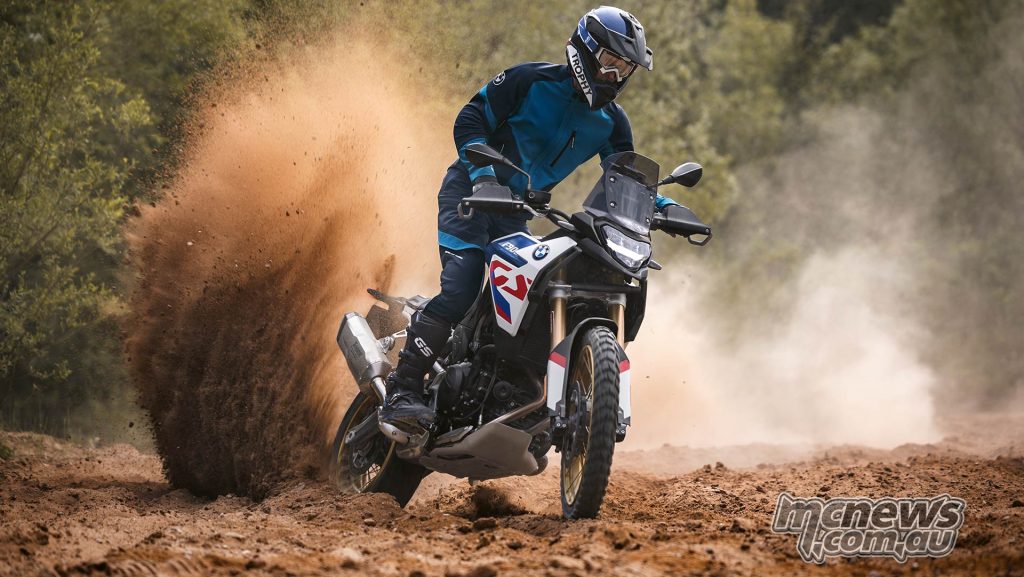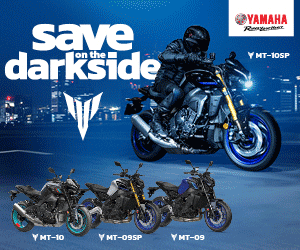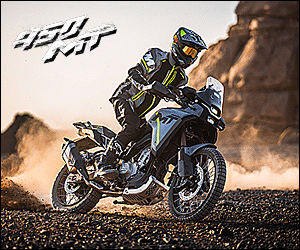2024 BMW F 900 GS
15 years ago BMW arguably instigated the middleweight twin-cylinder adventure motorcycle segment with the F 800 GS. Now this segment is packed with a range of options from just about every motorcycle manufacturer in the business, thus BMW have had to up their game to meet the challenge that a new slew of options in the market has given consumers, meet the new F 900 GS.

The original F 800 GS could never have been accused of being good looking. Recent models have steadily improved the aesthetics but it is clear this new model has seen them seriously step up their game in the styling stakes.

Likewise, early F 800 GS models were not all that exciting when it came to engine performance, something that at least, in-part, was done purposefully to make the bikes less threatening. Things stepped up a notch around five years ago with the introduction of the F 850 GS. The engine capacity was upped to 853 cc, power was increased to 95 neddies and the 850 makes 92 Nm of torque, these were useful gains that also came with a more engaging character to the engine that realised more smiles in your miles.

For 2024, with the advent of the new F 900 GS, engine capacity grows further to 895 cc. It continues the 270-degree crank design introduced with the 850, with a 2 mm larger bore realising the 42 cc increase in capacity. Claimed power now breaks intro triple digits, the F 900 GS pumping out 105 horsepower and 93 Nm of torque.

BMW are also continuing their frankly quite strange trend of selling a model badged with an engine capacity 100 cc less than it is equipped with, again this somehow is done to make the machine less intimidating… Thus in 2024 we also have an 895 cc F 900 GS detuned to 87 horsepower and called the F 800 GS.

The 800 also gets by with 60 mm less suspension travel and rides on an alloy 19-inch front rim compared to the spoked 21 of the more dirt oriented 900 models. This also translates to a much lower 815 mm seat height, compared to the 870 and 875 mm perches of the F 900 GS and F 900 GS Adventure models.

Of course weight is the real hurdle that many people struggle to get their head around, rather than engine power or badged capacity, but here the F 900 GS delivers with a massive 14 kg shed from its predecessor to now tip the scales at 219 kg ready to ride.

The new F 900 GS, F 900 GS Adventure and F 800 GS rely on a bridge-type frame made of deep-drawn sheet steel parts welded together, which integrates the 2-cylinder in-line engine as a supporting element. The 14.5-litre (500 ml less than before) plastic fuel tank of the new F 900 GS is a completely new development saving 4.5 kg of weight compared to the steel tank of the previous model. The F 900 GS features a completely redesigned rear section which looks more time and saved around 2.4 kg of weight. A further 1.7 kg are saved thanks to the rear silencer by Akrapovic.

BMW claim that lower placed pegs in combination with a new higher handlebar position and the new design of the fuel tank provide clear advantages, especially when riding standing up on rough terrain.

The new F 900 GS and F 900 GS Adventure feature new 43 mm, manually fully-adjustable, Showa upside-down telescopic forks with a generous 230 mm of travel. As before, the F 800 GS uses 41 mm forks with 170 mm suspension travel and no adjustments.

At the rear the 900 models are adjustable for pre-load and rebound damping with travel set at 215 mm. Dynamic ESA is optional. Rear travel on the F 800 GS is 170 mm.

The new F 900 GS can be given even more off-road prowess with the optional equipment ex works Enduro Pro package featuring fully adjustable titanium nitride-coated upside-down forks and fully-adjustable shock, complemented with handlebar risers and M Endurance chain.

All three new models already offer an adjustable gear-shift lever as standard. In conjunction with an optimised bearing and new gearshift lever kinematics, it was also possible to optimise shifting the six-speed transmission even further. The F 900 GS also features a new foot brake lever in a higher position.

BMW’s excellent 6.5-inch colour TFT display continues but now the lower F 800 GS model also scores the TFT screen and its accompanying multimedia functionality.

We are awaiting word from BMW Australia in regards to the delivery schedule of the new models and pricing changes.

2024 BMW F 900 GS Specifications
| F 900 GS | F 900 GS Adventure | |
| Engine | ||
| Capacity | 895 cc | |
| Bore/stroke | 86 x 77 mm | |
| Output | 77/105 kW/hp /8500 rpm | |
| Torque | 93 Nm /6750 rpm | |
| Type | Water-cooled, 2-cylinder, four-stroke in-line engine with four valves per cylinder operated by cam followers, two overhead camshafts and dry sump lubrication | |
| Compression | 13.1/1 | |
| Fuel | Premium unleaded 95 RON | |
| Valves per cylinder | 4 | |
| Ø intake/outlet | 33.5/27.2 mm | |
| Ø throttle valve | 48 mm | |
| Engine control | BMS-ME | |
| Emission control | Closed-loop three-way catalytic converter, exhaust emission standard EU-5+ | |
| Electrical System | ||
| Generator | 416 W | |
| Battery | 12V/Ah maintenance-free maintenance-free | |
| Headlight | LED | |
| Turn indicators | LED | |
| Starter | 900W | |
| Transmission | ||
| Clutch | Wet clutch with anti-hopping function, mechanically activated | |
| Gearbox | Claw-shift 6-speed gearbox | |
| Primary ratio | 1.821 | |
| I | 2.833 | |
| II | 2.067 | |
| III | 1.6 | |
| IV | 1.308 | |
| V | 1.103 | |
| VI | 0.968 | |
| Secondary drive | Endless O-ring chain with drive-train vibration damping in the rear wheel hub | |
| Secondary ratio | 2.765 | 2.588 |
| Chassis | ||
| Frame construction type | Bridge-type steel frame in shell construction, load-bearing engine | |
| Front-wheel suspension | USD telescopic forks, spring Front wheel suspension base, rebound and compression damping adjustable Ø 43 mm | |
| Rear wheel suspension | Aluminium double-sided swinging arm, directly linked WAD central spring strut, spring base and rebound damping adjustable (Optional equipment: sport suspension) (Option: Dynamic ESA) | |
| Spring travel, front/rear | 230/215 mm | |
| Wheel castor | 119.99 mm | |
| Wheelbase | 1,585 mm | |
| Steering head angle | 62 ° | |
| Brakes | Twin disc brake, floating | |
| Front Brake | Twin disc brake, floating brake discs, Ø 305 mm, 2-piston floating calipers | |
| Rear | Single disc brake, Ø 265 mm, 1-piston floating caliper | |
| ABS | Standard equipment BMW Motorrad ABS Pro (banking angle optimised) | |
| Wheels | Cross-spoke wheels | |
| Front | 2.15 x 21” | |
| Rear | 4.25 x 17” | |
| Front Tyre | 90/90-21 | |
| Rear Tyre | 150/70 R 17 | |
| Dimensions & Weights | ||
| Total length | 2,270 mm | 2,300 mm |
| Width | 943 mm | 939 mm |
| Seat height | 870 mm | 875 mm |
| DIN Weight | 219 Kg | 246 Kg |
| Permitted total weight | 445 Kg | 455 Kg |
| Fuel tank capacity | 14.5 l | 23 l |
| Performance | ||
| Fuel consumption | 4.4 l/100 km | |
| CO2 | 103 g/km | |
| 0-100km/h | 3.8 s | 3.7s |
| Top speed | 200 Km/h | |
2024 BMW F 800 GS Specifications
| F 800 GS | ||
| Engine | ||
| Capacity | 895 cc | |
| Bore/stroke | 86 x 77 mm | |
| Output | 64/87 kW/hp /6750rpm | |
| Torque | 91 Nm /6750 rpm | |
| Type | Water-cooled, 2-cylinder, four-stroke in-line engine with four valves per cylinder operated by cam followers, two overhead camshafts and dry sump lubrication | |
| Compression | 13.1/1 | |
| Fuel | Premium unleaded 95 RON | |
| Valves per cylinder | 4 | |
| Ø intake/outlet | 33.5/27.2 mm | |
| Ø throttle valve | 48 mm | |
| Engine control | BMS-X | |
| Emission control | Closed-loop three-way catalytic converter, exhaust emission standard EU-5 | |
| Electrical System | ||
| Generator | 416 W | |
| Battery | 12V/Ah12/9 maintenance-free | |
| Headlight | LED | |
| Turn indicators | LED | |
| Starter | 900W | |
| Transmission | ||
| Clutch | Wet clutch with anti-hopping function, mechanically activated | |
| Gearbox | Claw-shift 6-speed gearbox | |
| Primary ratio | 1.821 | |
| I | 2.833 | |
| II | 2.067 | |
| III | 1.6 | |
| IV | 1.308 | |
| V | 1.103 | |
| VI | 0.968 | |
| Secondary drive | Endless O-ring chain with drive-train vibration damping in the rear wheel hub | |
| Secondary ratio | 2.588 | |
| Chassis | ||
| Frame construction type | Bridge-type steel frame in shell construction, load-bearing engine | |
| Front-wheel suspension | Telescopic forks Ø 41 mm | |
| Rear wheel suspension | Aluminium double-sided swinging arm, directly linked WAD central spring strut, spring base and rebound damping adjustable (Optional equipment: sport suspension) (Option: Dynamic ESA) | |
| Spring travel, front/rear | 170/170 mm | |
| Wheel castor | 106.1 mm | |
| Wheelbase | 1556 mm | |
| Steering head angle | 63 ° | |
| Brakes | Twin disc brake, floating | |
| Front Brake | Twin disc brake, floating brake discs, Ø 305 mm, 2-piston floating calipers | |
| Rear | Single disc brake, Ø 265 mm, 1-piston floating caliper | |
| ABS | Standard equipment BMW Motorrad ABS Pro (banking angle optimised) | |
| Wheels | Aluminium cast wheels | |
| Front | 2.50 x 19” | |
| Rear | 4.25 x 17” | |
| Front Tyre | 110/80 R-19 | |
| Rear Tyre | 150/70 R 17 | |
| Dimensions & Weights | ||
| Total length | 2926 mm | |
| Width | 910 mm | |
| Seat height | 815 mm | |
| DIN Weight | 227 Kg | |
| Permitted total weight | 440 Kg | |
| Fuel tank capacity | 15 l | |
| Performance | ||
| Fuel consumption | 4.3 l l/100 km | |
| CO2 | 99 g/km | |
| 0-100km/h | 4.2 s | |
| Top speed | 190 Km/h | |



























